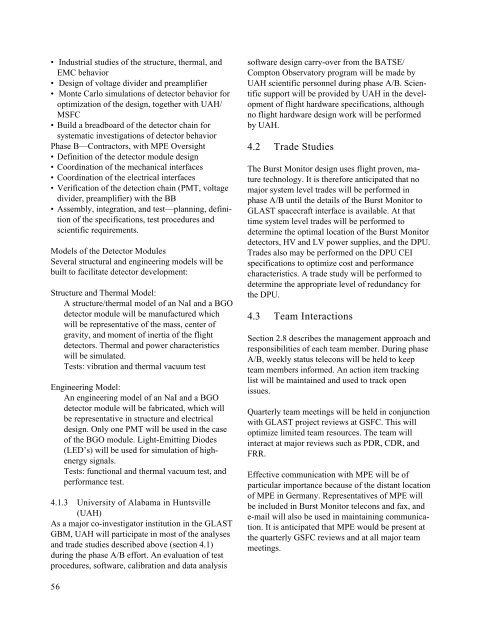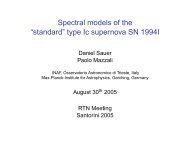Co-Investigator - The Gamma-Ray Astronomy Team - NASA
Co-Investigator - The Gamma-Ray Astronomy Team - NASA
Co-Investigator - The Gamma-Ray Astronomy Team - NASA
- No tags were found...
Create successful ePaper yourself
Turn your PDF publications into a flip-book with our unique Google optimized e-Paper software.
• Industrial studies of the structure, thermal, andEMC behavior• Design of voltage divider and preamplifier• Monte Carlo simulations of detector behavior foroptimization of the design, together with UAH/MSFC• Build a breadboard of the detector chain forsystematic investigations of detector behaviorPhase B—<strong>Co</strong>ntractors, with MPE Oversight• Definition of the detector module design• <strong>Co</strong>ordination of the mechanical interfaces• <strong>Co</strong>ordination of the electrical interfaces• Verification of the detection chain (PMT, voltagedivider, preamplifier) with the BB• Assembly, integration, and test—planning, definitionof the specifications, test procedures andscientific requirements.Models of the Detector ModulesSeveral structural and engineering models will bebuilt to facilitate detector development:Structure and <strong>The</strong>rmal Model:A structure/thermal model of an NaI and a BGOdetector module will be manufactured whichwill be representative of the mass, center ofgravity, and moment of inertia of the flightdetectors. <strong>The</strong>rmal and power characteristicswill be simulated.Tests: vibration and thermal vacuum testEngineering Model:An engineering model of an NaI and a BGOdetector module will be fabricated, which willbe representative in structure and electricaldesign. Only one PMT will be used in the caseof the BGO module. Light-Emitting Diodes(LED’s) will be used for simulation of highenergysignals.Tests: functional and thermal vacuum test, andperformance test.4.1.3 University of Alabama in Huntsville(UAH)As a major co-investigator institution in the GLASTGBM, UAH will participate in most of the analysesand trade studies described above (section 4.1)during the phase A/B effort. An evaluation of testprocedures, software, calibration and data analysissoftware design carry-over from the BATSE/<strong>Co</strong>mpton Observatory program will be made byUAH scientific personnel during phase A/B. Scientificsupport will be provided by UAH in the developmentof flight hardware specifications, althoughno flight hardware design work will be performedby UAH.4.2 Trade Studies<strong>The</strong> Burst Monitor design uses flight proven, maturetechnology. It is therefore anticipated that nomajor system level trades will be performed inphase A/B until the details of the Burst Monitor toGLAST spacecraft interface is available. At thattime system level trades will be performed todetermine the optimal location of the Burst Monitordetectors, HV and LV power supplies, and the DPU.Trades also may be performed on the DPU CEIspecifications to optimize cost and performancecharacteristics. A trade study will be performed todetermine the appropriate level of redundancy forthe DPU.4.3 <strong>Team</strong> InteractionsSection 2.8 describes the management approach andresponsibilities of each team member. During phaseA/B, weekly status telecons will be held to keepteam members informed. An action item trackinglist will be maintained and used to track openissues.Quarterly team meetings will be held in conjunctionwith GLAST project reviews at GSFC. This willoptimize limited team resources. <strong>The</strong> team willinteract at major reviews such as PDR, CDR, andFRR.Effective communication with MPE will be ofparticular importance because of the distant locationof MPE in Germany. Representatives of MPE willbe included in Burst Monitor telecons and fax, ande-mail will also be used in maintaining communication.It is anticipated that MPE would be present atthe quarterly GSFC reviews and at all major teammeetings.56



